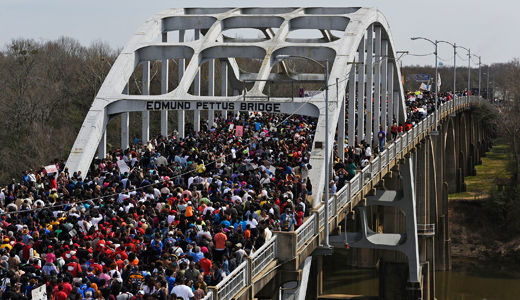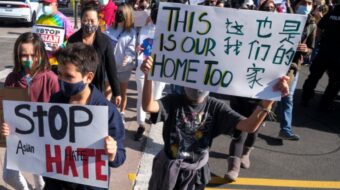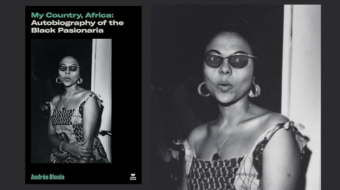
SELMA, Ala. – As my partner and I drove to Selma two weekends ago, thoughts reverberated within my head that I’m sure weighed on the minds of many progressives across the country: What perilous choices stood before the country in 1965 and what perilous choices stand before us today. Sure, there were practical concerns such as, where in the world are we going to park? But heavier matters dominated the thoughts and conversation of the drive.
I’ll go ahead and warn you from the start that this isn’t one of those articles about the 50th Anniversary of the Bridge Crossing at Selma that will leave you feeling fuzzy inside, but I hope it will motivate you to take action in order to build the type of future that the protestors at the Edmund Pettus Bridge risked, and in several instances lost, their lives for in 1965.
Those us who live in Alabama are used to seeing short local news reports concerning the commemoration every March but not much else. Of course, for the 50th anniversary there was a larger crowd, more national media coverage, and more high-profile speakers, with even President Obama coming to rouse the crowd. This year the event brought with it a uniquely larger impression on the national consciousness than any memory I have of previous commemorations.
It should have been an unencumbered celebration, an event where we as a nation were able to decry the injustices of the past and celebrate our shining present and bright future. Instead, it was a gathering of approximately 80,000 people who for the most part seemed to realize that we have a long march ahead of us. There were grievances which had to be expressed, some of which looked all too similar to those of 1965. If Fannie Lou Hamer said more than 50 years ago “I’m sick and tired of being sick and tired,” Lord knows she would be past the point of exhaustion by now.
Where have all the voting rights protections gone?
What many times is referred to as the crown of the 1960s civil rights movement, the Voting Rights Act of 1965, now lies lame and declawed 50 years later. A downright reactionary majority within the Supreme Court gutted the historic legislation over a year ago, striking down its provisions which mandated federal oversight to any changes in voting rules by states with a history of discrimination. Since that decision, many of these states have moved to ratify a multitude of new, superfluous restrictions to poll access which especially target low-income voters, people of color, and women. The most infamous and widespread alterations to voting procedures have been the requirement for photo ID at the polls and further restrictions on early voting.
Further alienating common people from the democratic process, we have also experienced some of the devastatingly negative effects of the same court’s Citizens United decision. The decision’s outcome opened the flood gates to an unprecedented amount of corporate-interest money being funneled into our election cycles. In 2012, for instance, the Koch brothers and the organizations and Super PACs connected to their efforts routed enough cash into right-wing candidates’ coffers that the top ten labor unions in the country were outspent 2-1. Plus, the same 5-4 majority in the SCOTUS ruled in the McCutcheon decision of 2014 that caps on private individuals’ contributions to political campaigns are “unconstitutional.”
As David Cobb, representative of the anti-corporate personhood coalition Move to Amend, is fond of saying, “the most dangerous threat to democracy in the United States of America is the mistaken belief that we actually practice one.” As John Lewis spoke before the President’s speech in Selma, I wondered how disillusioned he must feel. He has made some comments on social media recently about how things are different, but I don’t think he has any illusions that we’re close to being there yet either. In other words, Selma 2015 was still not the place for a celebration of the crowning achievements of American democracy. It served as less of a commemoration than a rallying point for continuing the civil rights movement.
Ferguson tactics draw ire from boomer liberals
We must not forget that this event marks the historical brutalization of hundreds of protestors, predominantly black, at the hands of a violent white police force. We can’t let the balloons, festivities, souvenirs, or even a sitting African-American president hide that. This past year has seen an outburst of revelations regarding the oppression of people of color by institutions whose raison d’être is supposedly to “serve and protect.” The Department of Justice (DOJ) just a few days ago released a report detailing the cruel and racist activities of the police department of Ferguson, Missouri. Ferguson has become the center of national attention for police brutality and unfair treatment directed against people of color. According to the DOJ’s report, the Ferguson Police Department’s “approach to law enforcement…results in patterns of unnecessarily aggressive and at times unlawful policing; reinforces the harm of discriminatory stereotypes; discourages a culture of accountability; and neglects community engagement.”
Several young organizers from Ferguson made their way to Selma to join in this year’s events and were present throughout the weekend. They staged their own protest on Sunday, independent of the planned ceremonies, where several from their group lay down on the bridge to draw attention to the deaths of young black people at the hands of U.S. police departments, a “die-in,” as they are called. This served to connect the dots between the bloodshed of 1965 and the continuing brutalization of people of color by police across the nation. The action took place in the path of the bridge-crossing ceremony itself and seemed to draw plenty of criticism from many of the marchers.
To be frank, the reaction was a bit disturbing. Although some marchers joined in with them, there was an observable “don’t rain on our parade” attitude displayed by many of the participants, who seemed to be more comfortable with establishment politics and getting a t-shirt than grassroots direct action. Apparently, some have forgotten the frequently disruptive tactics of civil disobedience which permeated the civil rights movement of the 1960s. I, for one, thought this was one of the most “respectable” actions of the weekend.
The generation gap problem is not a new one but might be likened to the struggles between the old and new left during the 1960s. The problem of racially motivated police violence is not a new problem either. However, it has received more of the public spotlight in the past year, and that media shift is largely due to tactics like those employed by the Ferguson protestors at Selma. Without these types of disruptive tactics, Mike Brown may have been just another name added to the list of young black men gunned down by police officers in the U.S. In response to both the spontaneous and organized large-scale demonstrations in Ferguson, protests popped up in cities across the nation with similar grievances about the relationship between their own local police forces and minority communities. “Black Lives Matter” has become a national refrain, and it was proclaimed loudly by signs, shirts, and voices in Selma this year.
Labor shows up even when trouble is brewing elsewhere
The AFL-CIO publicly came to terms at its 2013 convention with the fact that the future of U.S. labor is largely contingent on a Southern Organizing Strategy. Considering this, it seems only sensible that labor would send its forces out in droves to an event like Selma 2015, in order to make itself starkly visible to the Southern working class. However, as Wisconsin’s General Assembly passed so-called Right-to-Work legislation on the anniversary date of Bloody Sunday, one might think that these large gatherings of union members would be needed in Madison this weekend.
I got a chance to speak briefly with Greg Fann, president of the Metro Atlanta Chapter of the Coalition of Black Trade Unionists, about the high-volume participation of trade unionists at the Bridge Crossing. Fann made the following keen remarks about labor’s lingering connection to the events at Selma: “There’s always a connection between the pocketbook and the ballot box. Dr. King understood that. Americans need both rights at work and participation in the voting booth for any effective change to be realized through either.” The integral relationship between electoral politics and organized labor has been especially exposed on the state level within the last few years, as traditionally strong labor states like Michigan and Wisconsin have seen major setbacks and attacks on collective bargaining from state legislators and governors’ offices controlled by the extreme right.
Let’s not pretend for one second that we don’t know the key factor for why the right maintains control of these offices, and it’s not merely gerrymandering. The cognitive dissonance between the outcomes of U.S. electoral cycles and class interests is firmly rooted in racism. This weekend, as I considered how so many white, working-class voters around the country still play the pawn in the politics of racial divide and conquer, the following statement by Dr. King at the conclusion of the march from Selma kept ringing in my head: “If it may be said of the slavery era that the white man took the world and gave the Negro Jesus, then it may be said of the Reconstruction era that the Southern aristocracy took the world and gave the poor white man Jim Crow.”
Fifty years after the events at Selma, the reality is that the majority of white, working-class voters still seem to have their low wages supplemented by what W.E.B. DuBois called the “psychological wage” of white supremacy. This is made evident by the consistent refusal of the majority of white workers to enter into labor or electoral coalitions with black, working-class progressives, even at the cost of their own material interests. I think most within the labor movement know this fact all too well, yet since the election of the first African-American U.S. president in 2008, progressives would be fooling themselves to claim they haven’t witnessed a transformation in the politics of racial prejudice, from the dog whistle variety popularized by the likes of Lee Atwater in the 1980s to a conspicuous fever pitch reminiscent of earlier eras. That’s one of the major reasons we can’t see Selma as just a commemoration but a continuation.
Is that hope on the horizon or just a bumper sticker from 2008?
I am convinced that we must start looking more soberly at the political shifts taking place in our country if we want movements for justice and equality to be effective. There must be a sense of urgency among the progressive masses to take us where we need to go. Upworthy posts are just not going to do that, folks. A confused statement from a millionaire actress on an awards show is not going to save us, and it is not a sign of the revolutionary political shift we desperately need. The demands of our culture to “stay positive” many times undermine our critical abilities. Progressive workers have real enemies, difficult challenges, and deep-seated pains which we deal with daily due to the soul-crushing and physically unhealthy machinations of patriarchy, white supremacy, heteronormativity, and capitalism. There’s no way we deal with that by just keeping a positive attitude.
All of that said, I couldn’t possibly have left this event without some optimism. For a lot of people, including myself, the 50th Anniversary of the Bridge Crossing at Selma represents hope in the midst of trials, courage in the midst of uncertainty and imminent existential threats. Where cruelty, barbarism, marginalization, oppression, and exploitation abound, people can still dream and push the moral arc of the universe toward justice. That’s still what Selma tells us.
There is a movement in the streets to restore the Voting Rights Act’s key provisions, and even our cautious president is lending his voice to it. Young black and brown agitators and their allies are breaking the silence about racist police violence in their communities, and they are confronting it by both bold acts of spontaneous resistance and organizational strategy. From the local union hall down the street to the offices of the leadership of the AFL-CIO, the trade union movement in the U.S. is moving toward organizing the South and a more intentional strategy of opposing racism within its own ranks and beyond. These are all things that can keep our hope alive.
Through all of the political challenges that face us and even through my own occasional bouts of personal dreariness, I am enlivened with that same confidence expressed in the chant the Ferguson protestors recited at the Edmund Pettus Bridge on Sunday. Although sounded by a tired and weary voice that floats somewhere between a lament, a prayer, and a hope, I believe that we will win!
Photo: Bill Frakes/AP










